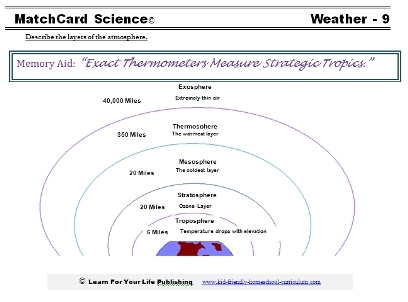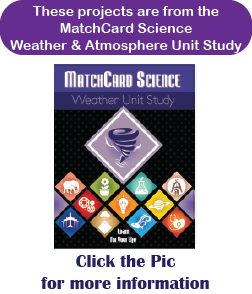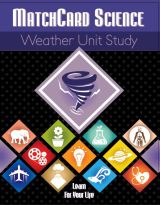Layers of the Atmosphere
The Layers of the Atmosphere MatchCard allows kids to learn the different levels of the earth's atmosphere
Free Download Below


The Earth's Atmosphere
Objective: Identify the layers of the earth's atmosphere: exosphere, thermosphere, mesosphere, stratosphere, and troposphere.This MatchCard will identify the five layers, provide a memory aid, provide a review MatchCard, describe an experiment to visualize the atmospheric effect of temperature and pressure changes, and suggest a hands on project.
Print the Atmosphere MatchCard
This is MatchCard #9 of the Weather Unit Study. Directions for using MatchCards are below.Let's Compare the Layers of the Atmosphere
There are five layers of the earths atmosphere.Troposphere
The troposphere is the first six miles of the atmosphere around the earth.75% of the earth's mass is in the troposphere.
With increased elevation, there is a decrease in air pressure and temperature.
Stratosphere
The stratosphere is the next layer above the troposphere.The ozone layer is contained within the stratosphere.
The stratosphere is 20 miles high (above the six miles of troposphere.)
Mesosphere
The mesosphere is the next layer above the stratosphere.It is the coldest layer of the earth's atmosphere.
The stratosphere is 20 miles high (the same depth as the stratosphere.)
Thermosphere
The stratosphere is the next layer above the mesosphere.It is the hottest layer of the atmosphere.
The stratosphere is 350 miles high.
Exosphere
The exosphere is the layer furthest from the earth's surface.The air is extremely thin as molecules are far apart.
The exosphere is 40,000 miles from its beginning to its end.
Let's Experiment
Here is a simple experiment to demonstrate the relationship between atmospheric temperature and pressure.- Get an empty plastic milk jug that has been washed out. You will need its lid.
- Pour hot water into the jug so it is half full. Adult supervision is needed.
- Observe what happens to the jug in the next 20 to 30 minutes.
- Now, put the jug either in the refridgerator or a larger pan of ice water.
Explanation Please:
When you put the hot water into the jug and sealed it, you caused the air above the water to become warmer.
Warm air expands. Therefore the jug expanded.
When you cooled the air, the molecules became closer together. This caused the jug to collapse.
Make A Poster
Have the students make a poster of the layers of the atmosphere.They may use any artistic media. Other information they find about the earth's atmosphere should also be included.
Encourage them to include a bibliography.
Memory Aid
The names of the different layers are easy to remember - and then forget. I have found this mnemonic helpful:Exact Thermometers Measure Strategic Tropics
They will be able to rattle off those layers effortlessly!MatchCard Science
How To Use MatchCards

Download the FREE MatchCard Science Instructor's Guide and see how MatchCards can make building their science knowledge base fun.
Weather Unit Study

Nine different weather lessons can be presented in this 4 week study.
Download the entire Weather Unit Study.
12 Science Unit Studies

Chemistry is only one of twelve complete unit studies for kids in 3rd to 8th grade.
Comprehensive objectives, hands-on projects, suggested science fair experiments, and the fun game-like MatchCards keep them interested in learning science. See all twelve MatchCard Science Unit Studies.
About Our Site
Hands-On Learning














